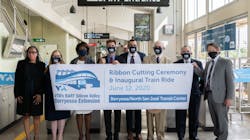Phase 1 of BART extension to Silicon Valley begins service
Dual ribbon cutting ceremonies were held to open the first phase of the Bay Area Rapid Transit (BART) Silicon Valley Extension on June 12, first at the Berryessa/North San José Transit Center and then at the Milpitas Transit Center. Regular passenger service on the extension began Saturday, June 13.
The opening of the 10-mile extension enhances regional connectivity through a transit link between Santa Clara County, Oakland and San Francisco and is the result some at the ribbon cutting ceremonies had been waiting to see for more than 30 years.
San José Mayor Sam Liccardo said the opening of the project offered a moment of respite from recent challenges–he mentioned the COVID-19 pandemic, systemic racism, homelessness and unemployment levels—but he noted the moment served as a reminder of what can be accomplished through working together.
“As they say, ‘success has a thousand parents,’ particularly when it involves a project of this size,” said Mayor Liccardo. “There was never any question from the city of San José that we were going to get this done.”
The Santa Clara Valley Transportation Authority (VTA) broke ground on Phase 1 of the project in 2012 with the rail connection between BART’s Warm Springs Station following the former Union Pacific corridor through Milpitas to the Berryessa District of San José. Santa Clara VTA designed, funded and built the systems and facilities. BART will operate the service and maintain the systems and two new BART stations located within Santa Clara VTA’s new transit centers in Milpitas and North San José. Phase 2 will further extend the line by six miles to Santa Clara.
Santa Clara VTA turned control of the $2.3-billion extension over to BART in June 2019 with pre-revenue testing beginning in October 2019 before both BART and Santa Clara VTA agreed to pause the testing in order to redevelop a work plan that lead the agencies to the opening of the extension on June 13.
“Historic is the appropriate word for this moment,” said Santa Clara VTA General Manager and CEO Nuria Fernandez. “This is a time when new pathways for mobility are more important than ever. We need to strengthen our network of connectivity.”
She too mentioned the civil unrest taking hold across the nation and noted the importance public transit plays in delivering equality.
“Public transportation is the greatest equalizer; it provides access to opportunities to everyone,” said Fernandez.
In a blog post about the ribbon cutting ceremonies, Santa Clara VTA explained that connectivity is key at the Milpitas Transit Center, where riders will have access to BART’s Daly City Green line and Richmond Orange line, Santa Clara VTA’s Orange Line (light-rail service connecting North San José, Sunnyvale and Mountain View), nine VTA bus routes (Lines 20, 44, 47, 60, 66, 70, 71, 77 and Express 104) and AC Transit’s Route 217.
The Berryessa Transit Center offers direct connections via Santa Clara VTA’s new Rapid 500 bus to San José State University, downtown San José and the Diridon Caltrain Station.
The design-build project was built under the Skanska, Shimmick and Herzog (SSH) joint venture. Lockwood, Andrews & Newnam, Inc., served as the lead designer under the SSH joint venture contract.
About the Author

Mischa Wanek-Libman
Group Editorial Director
Mischa Wanek-Libman is director of communications with Transdev North America. She has more than 20 years of experience working in the transportation industry covering construction projects, engineering challenges, transit and rail operations and best practices.
Wanek-Libman has held top editorial positions at freight rail and public transportation business-to-business publications including as editor-in-chief and editorial director of Mass Transit from 2018-2024. She has been recognized for editorial excellence through her individual work, as well as for collaborative content.
She is an active member of the American Public Transportation Association's Marketing and Communications Committee and served 14 years as a Board Observer on the National Railroad Construction and Maintenance Association (NRC) Board of Directors.
She is a graduate of Drake University in Des Moines, Iowa, where she earned a Bachelor of Arts degree in Journalism and Mass Communication.
